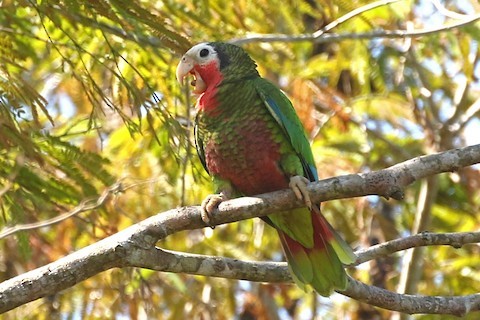Birdfinding.info ⇒ The Cuban endemic form of Rose-throated Parrot has become rare across most of its natural range, but it remains fairly common in the Zapata Swamp area, where it can be found reliably at Playa Larga, Soplillar, and Bermejas Wildlife Refuge. Other areas where it is still seen regularly include Topes de Collantes and Alejandro de Humboldt National Parks.
“Cuban Parrot”
Amazona leucocephala leucocephala
Endemic to Cuba and its satellites, including the Isle of Youth and the Jardines del Rey Archipelago, where it inhabits various types of woodlands.
Formerly occurred the full length of the island at all elevations, but a history of persecution as a cagebird commodity has reduced its numbers and distribution. In 2020 the total population was estimated in the range of 7,000 to 14,000.
Its main center of abundance is the Zapata Swamp region. Other areas that remain partly occupied include the Isle of Youth and two national parks: Topes de Collantes in central Cuba, and Alejandro de Humboldt in the far southeast.
Elsewhere, scattered flocks persist on the Guanahacabibes Peninsula, in the mountains of Pinar del Río, metropolitan Havana (presumably introduced), northern Ciego de Ávila, the Sierra de Najasa, coastal Holguín, and the Sierra de Maestra.
Identification
The only wild parrot in Cuba. Its most prominent features include a white forecrown and face, pale bill, and pink bib that extends from the cheeks and throat down onto the chest.
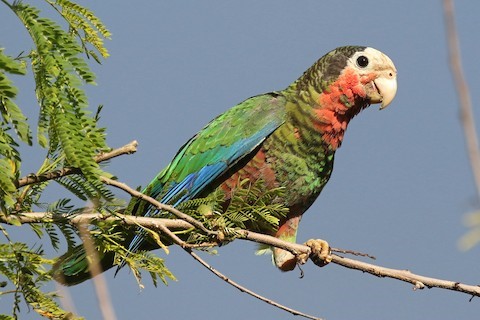
“Cuban Parrot”, A. l. leucocephala. (Playa Larga, Matanzas, Cuba; March 17, 2020.) © Jeffrey Offermann
The head, neck, back, and chest have a dark, scaly appearance because the feathers are partly green with variably broad blackish tips, typically darkest around the ear.

“Cuban Parrot”, A. l. leucocephal, showing pink on the throat and maroon on the belly. (Criadero de Cocodrilos, Matanzas, Cuba; December 16, 2017.) © Pam Campbell
The belly is variably infused with maroon, which is also present on the underside of the tail at the base of the outer feathers.
The upperside of the wing is mostly bluish. The underside usually appears mostly green with a black tip and trailing edge.
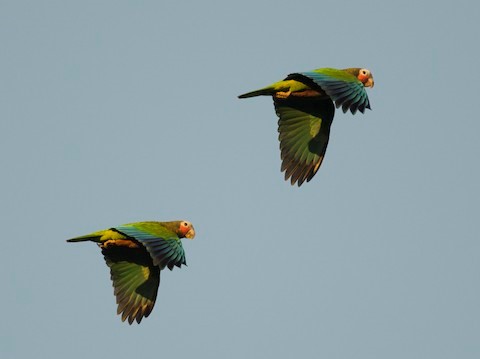
“Cuban Parrot”, A. l. leucocephala, in flight, showing blue on the wings. (Playa Larga, Matanzas, Cuba; February 14, 2015.) © Joshua D. Vandermeulen
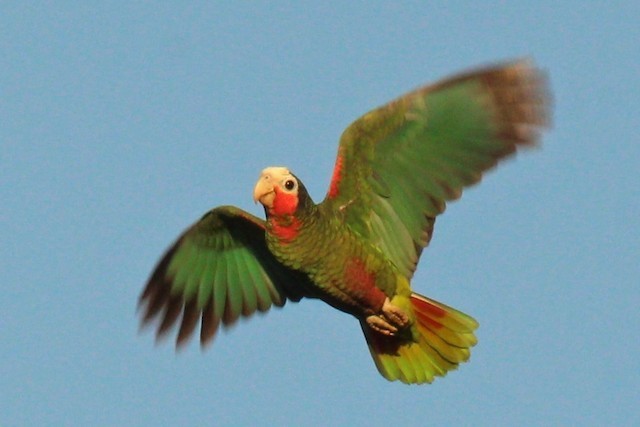
“Cuban Parrot”, A. l. leucocephala, ventral view in flight, showing maroon on belly and base of outer tail feathers. (Bermeja Wildlife Refuge, Matanzas, Cuba; December 8, 2016.) © Jason Estep
Notes
Monotypic form, one of three potentially distinct forms of Rose-throated Parrot (leucocephala). The combined species is usually referred to collectively as the Cuban Parrot, but it makes sense to reserve the geographical tag for use when differentiating the forms as distinct, potentially separate species. Raffaele et al. (1998) instead adopt the name Rose-throated Parrot, which seems clearly preferable as it avoids the ambiguity and emphasizes the most prominent feature that the forms share in common.
IUCN Red List Status: Near Threatened.
See below for a comparison of the “Cuban Parrot” with the “Bahama” and “Cayman” Parrots.
Cf. “Bahama” and “Cayman” Parrots. The “Cuban”, “Bahama”, and “Cayman” Parrots are traditionally classified as forms of a single species, which may be appropriate, but their taxonomic status is not definitively settled. Although they do not occur together naturally, vagrancy or transport of captive individuals could take them out of their expected ranges and cause confusion. “Cuban” and “Bahama” both differ from “Cayman” in having far more extensive white on the head and more extensive and contiguous pink on the face, throat, and chest. “Cuban” and “Bahama” differ from one another mainly in the coloration of the belly: green on “Bahama” versus maroon on many “Cubans”. As on “Cuban”, the “Cayman Parrot” often shows extensive maroon on the belly.
More Images of the “Cuban Parrot”
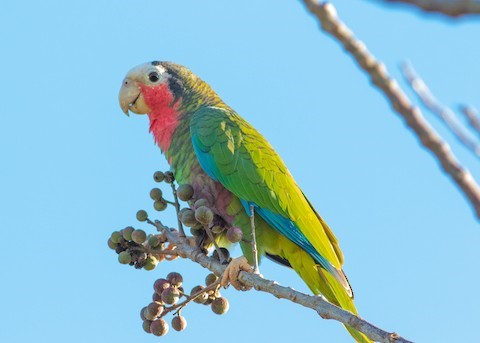
“Cuban Parrot”, A. l. leucocephala. (Soplillar, Matanzas, Cuba; February 9, 2018.) © Mikko Pyhälä
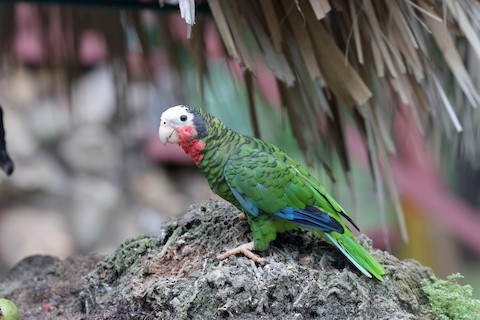
“Cuban Parrot”, A. l. leucocephala. (Sendero Palpite, Matanzas, Cuba; September 7, 2015.) © Holger Teichmann

“Cuban Parrot”, A. l. leucocephala. (Zapata Swamp, Cuba; March 2013.) © Ian Merrill
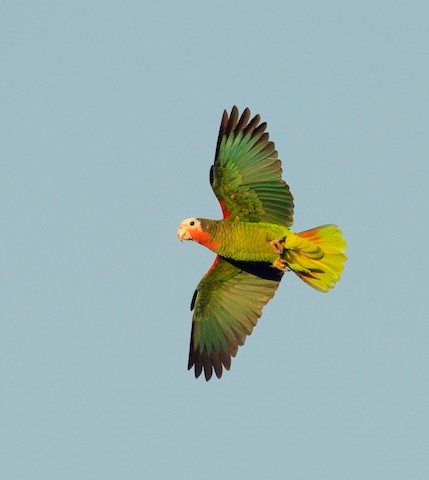
“Cuban Parrot”, A. l. leucocephala, ventral view in flight—note that this individual has an all-green belly. (Playa Larga, Matanzas, Cuba; February 13, 2017.) © Joshua D. Vandermeulen
References
BirdLife International. 2020. Amazona leucocephala. The IUCN Red List of Threatened Species 2020: e.T22686201A179212864. https://dx.doi.org/10.2305/IUCN.UK.2020-3.RLTS.T22686201A179212864.en. (Accessed January 31, 2022.)
Bond, J. 1979. Birds of the West Indies (Fourth Edition). Collins, London.
eBird. 2022. eBird: An online database of bird distribution and abundance. Cornell Lab of Ornithology, Ithaca, N.Y. http://www.ebird.org. (Accessed January 31, 2022.)
Forshaw, J.M. 2010. Parrots of the World. Princeton University Press, Princeton, N.J.
Juniper, T., and M. Parr. 1998. Parrots: A Guide to Parrots of the World. Yale University Press.
Kirwan, G.M., A. Levesque, M. Oberle, and C.J. Sharpe. 2019. Birds of the West Indies. Lynx Edicions, Barcelona.
Raffaele, H., J. Wiley, O. Garrido, A. Keith, and J. Raffaele. 1998. A Guide to the Birds of the West Indies. Princeton University Press.
Xeno-Canto. 2022. Cuban Amazon – Amazona leucocephala. https://xeno-canto.org/species/Amazona-leucocephala. (Accessed January 31, 2022.)
